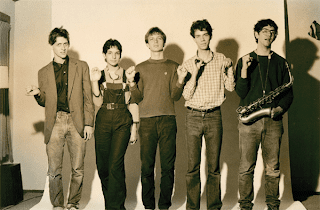



A. The Middle Room
B. Torture
NEMB (Baltimore, MD)
The Middle Room b/w Torture
Green Records, 1981
Lee Warren grew up in Daytona Beach, FL. His musical taste was highly influenced by the discovery of Alice Cooper and New York Dolls records in the early 70s. From there he got into glitter bands like David Bowie, Roxy Music, and other stuff from England he had read about in the pages of Melody Maker and Rock Scene.
In 1977, Lee started attending the University of South Florida in Tampa. At the time, southern rock like Lynyrd Skynyrd and Charlie Daniels Band dominated the airwaves and the live club circuit, which he wanted nothing to do with. Fundamentally, he liked the sound of distorted guitar and when he moved to Tampa and found others who shared a common interest, he immediately set out to form a band.
Lee introduced himself to a student in a dorm hallway who was wearing a Kinks t-shirt. His name was Bill Carey and he had transplanted from Naples, FL to attend school at USF. Bill collected vintage guitars and was a fan of bands like the Velvet Underground, Stooges, NY Dolls, Mott The Hoople, and the early CBGB groups.
Realizing they were into a lot of the same music, the two started frequenting Mi Backyard, a kind of a redneck bar with a picnic and BBQ area that began having punk nights in the spring of 1978. The first time they went they saw a power pop band called Just Boys playing. It was decided that they needed to form their own band.
They started writing songs together with Lee singing and Bill on guitar. Then they brought in Bill’s girlfriend Joyce who also played guitar. They posted ads on bulletin boards around campus to find other members and met a bass player named David Bowman. They completed the line-up with a 15 year old drummer named Val who was an advanced placement student in college. She had a Mo Tucker sensibility about the way she played minimalist drums without utilizing cymbals.
They named the band the Art Holes and played their first gig at a rehearsal space rented out by members of a local band called the Jackers. Lee never sang in front of people before and had a bit of stage fright, but they made it through the show and people liked them. The band started getting other gigs around town and neighboring Sarasota. Eventually Allen Esser took Val’s place on drums and gave the band a more powerful sound.
Lee graduated in 1979 and moved up to Baltimore. Bill and Dave continued playing together in a band called the Jetsons, who later became Stick Figures. Meanwhile, Lee began working on songs with a drummer named Rick Sugden, who had coincidentally had a short stint in the Jetsons. In late summer/early fall of 1980, Lee met George Poscover through an ad he'd posted in a record store. Rick sort of drifted away once George came into the picture and since they couldn’t find another drummer, Lee bought a Roland CR-78 rhythm machine.
Lee called the band Non-Erotic Male Bonding, or NEMB for short, since some club owners objected to the full version of the name. On Saturday April 4, 1981 a Gender-Fuck Party was held where attendees went into a closet where a Bolex film camera was setup with a cable release that advanced the film one frame at a time. On that night a version of NEMB that included Lee, George, and a guitar player named Charles Freeman performed.
Lee’s old band mates Bill and Dave took a hiatus from Stick Figures and came up to Baltimore in the summer of 1981. They joined Lee and George, who were working on some NEMB demos. The temporary line-up recorded two songs that would be released as NEMB’s sole output in a run of 500 copies. Their version of “The Middle Room” became the soundtrack to the Gender Fuck Party film that had previously been shown without an audio track. Lee and George can be seen in the film between :07 and :14.
Bill, Dave, and the rest of Stick Figures ended up moving to New York and tried to get something going there. Unfortunately things didn’t pan out and the band soon drifted apart. Lee wanted to move to New York as well which brought an end to NEMB. In February 1982, Lee and Bill along with Rachel Bowman from Stick Figures formed a new band called King Of Culture. They played frequently in New York for a couple years with numerous line-up changes and released a single on Green Records. Not making enough money to sustain themselves, the band eventually split apart.













































